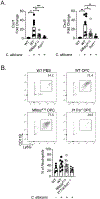IκBζ is an essential mediator of immunity to oropharyngeal candidiasis
- PMID: 37725983
- PMCID: PMC10591851
- DOI: 10.1016/j.chom.2023.08.016
IκBζ is an essential mediator of immunity to oropharyngeal candidiasis
Abstract
Fungal infections are a global threat; yet, there are no licensed vaccines to any fungal pathogens. Th17 cells mediate immunity to Candida albicans, particularly oropharyngeal candidiasis (OPC), but essential downstream mechanisms remain unclear. In the murine model of OPC, IκBζ (Nfkbiz, a non-canonical NF-κB transcription factor) was upregulated in an interleukin (IL)-17-dependent manner and was essential to prevent candidiasis. Deletion of Nfkbiz rendered mice highly susceptible to OPC. IκBζ was dispensable in hematopoietic cells and acted partially in the suprabasal oral epithelium to control OPC. One prominent IκBζ-dependent gene target was β-defensin 3 (BD3) (Defb3), an essential antimicrobial peptide. Human oral epithelial cells required IκBζ for IL-17-mediated induction of BD2 (DEFB4A, human ortholog of mouse Defb3) through binding to the DEFB4A promoter. Unexpectedly, IκBζ regulated the transcription factor Egr3, which was essential for C. albicans induction of BD2/DEFB4A. Accordingly, IκBζ and Egr3 comprise an antifungal signaling hub mediating mucosal defense against oral candidiasis.
Keywords: Candida albicans; IL-17 signaling; cytokines; defensins; oral epithelium; signal transduction.
Copyright © 2023 Elsevier Inc. All rights reserved.
Conflict of interest statement
Declaration of interests The authors declare no competing interests.
Figures







Comment in
-
Delving into the adytum of the IL-17 defense pathway.Cell Host Microbe. 2023 Oct 11;31(10):1599-1601. doi: 10.1016/j.chom.2023.08.021. Cell Host Microbe. 2023. PMID: 37827120
References
MeSH terms
Substances
Grants and funding
LinkOut - more resources
Full Text Sources
Medical
Molecular Biology Databases
Research Materials

